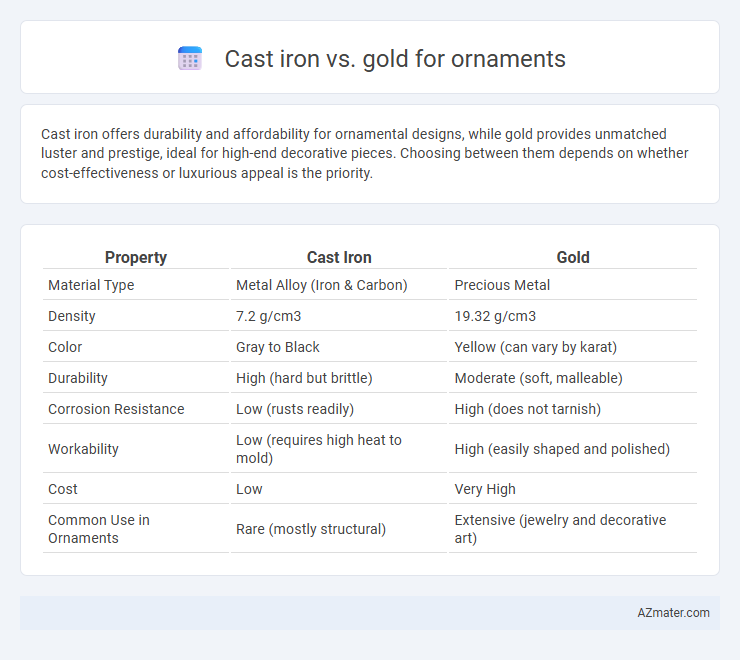Cast iron offers durability and affordability for ornamental designs, while gold provides unmatched luster and prestige, ideal for high-end decorative pieces. Choosing between them depends on whether cost-effectiveness or luxurious appeal is the priority.
Table of Comparison
| Property | Cast Iron | Gold |
|---|---|---|
| Material Type | Metal Alloy (Iron & Carbon) | Precious Metal |
| Density | 7.2 g/cm3 | 19.32 g/cm3 |
| Color | Gray to Black | Yellow (can vary by karat) |
| Durability | High (hard but brittle) | Moderate (soft, malleable) |
| Corrosion Resistance | Low (rusts readily) | High (does not tarnish) |
| Workability | Low (requires high heat to mold) | High (easily shaped and polished) |
| Cost | Low | Very High |
| Common Use in Ornaments | Rare (mostly structural) | Extensive (jewelry and decorative art) |
Introduction to Cast Iron and Gold Ornaments
Cast iron ornaments offer durability and a vintage aesthetic, often featuring intricate designs achieved through molding and forging. Gold ornaments are prized for their luster, malleability, and resistance to tarnish, symbolizing luxury and timeless elegance in jewelry and decorative arts. Both materials serve distinct purposes, with cast iron favored for robust, industrial-style decor and gold preferred for high-value adornments and ceremonial pieces.
Historical Use of Cast Iron and Gold in Ornamentation
Cast iron has been used in ornamental design since the 18th century, prized for its durability and intricate casting capabilities during the Industrial Revolution, especially in architectural elements and garden ornaments. Gold's role in ornamentation dates back thousands of years, symbolizing wealth and status in ancient civilizations such as Egypt and Mesopotamia, where it was often crafted into jewelry and ceremonial objects due to its malleability and luster. The historical use of cast iron reflects industrial advancements and mass production, while gold embodies timeless luxury and craftsmanship in decorative arts.
Aesthetic Appeal: Cast Iron vs Gold
Gold offers unparalleled aesthetic appeal with its lustrous shine, warm tones, and timeless elegance, often symbolizing wealth and luxury in ornaments. Cast iron provides a rustic, industrial charm with its matte, dark surface and ability to develop a unique patina over time, lending a vintage or steampunk-inspired look to decorative pieces. While gold's brilliance and malleability enhance intricate designs, cast iron's robustness and earthy texture create bold, statement-making ornaments with a distinctive aesthetic.
Durability and Longevity Comparison
Cast iron exhibits remarkable durability due to its high tensile strength and resistance to wear, making it suitable for heavy-duty ornamental use with long-lasting structural integrity. Gold, while highly resistant to corrosion and tarnish, is softer and more prone to scratches and deformation over time, which can affect its appearance and longevity as an ornament. Consequently, cast iron offers superior longevity in rugged conditions, whereas gold excels in maintaining its aesthetic appeal in delicate, fine jewelry applications.
Cost Analysis: Cast Iron vs Gold Ornaments
Cast iron ornaments offer a significantly lower cost compared to gold, with prices often being a fraction of the expense due to the abundant availability and simple manufacturing processes of cast iron. Gold ornaments possess a much higher market value driven by their rarity, intrinsic precious metal content, and craftsmanship associated with fine jewelry, making them a long-term investment but less accessible for budget-conscious consumers. When comparing cost efficiency, cast iron is ideal for decorative purposes with minimal financial risk, whereas gold serves as both a luxury ornament and a store of wealth.
Maintenance and Care Requirements
Cast iron ornaments require regular preventive maintenance to avoid rust, including cleaning with a dry cloth and applying a protective oil layer, while gold ornaments demand minimal upkeep due to their resistance to tarnish and corrosion. Gold's non-porous surface allows for easy cleaning with mild soap and water, whereas cast iron must be thoroughly dried to prevent moisture-induced damage. Proper storage in dry environments significantly extends the lifespan of both materials, but gold's inherent durability makes it more suitable for long-term wear with less frequent care.
Versatility in Design and Application
Cast iron offers exceptional versatility in design due to its malleability and strength, enabling intricate patterns and durable outdoor ornaments. Gold excels in ornamental applications with its luxurious appearance and resistance to tarnish, ideal for fine jewelry and high-end decorative pieces. While cast iron suits large-scale and functional decor, gold remains unmatched for detailed, prestigious designs requiring longevity and elegance.
Environmental Impact and Sustainability
Cast iron production involves high carbon emissions and significant energy consumption, posing environmental challenges due to mining and smelting processes. Gold mining results in habitat destruction, heavy chemical usage, and considerable water pollution, raising concerns about its ecological footprint and sustainability. Sustainable alternatives include recycling metals and sourcing from certified responsible mines to reduce environmental impact in jewelry manufacturing.
Popular Uses in Modern Decor
Cast iron is commonly used in modern decor for rustic and industrial-style ornaments due to its durability, weight, and matte finish, making it ideal for sturdy decorative pieces like candle holders and planters. Gold ornaments, popular in contemporary and luxury interiors, add a touch of elegance and opulence with their shiny, reflective surface, often featured in intricate jewelry, sculptures, and accent furnishings. Both materials enhance spaces differently, with cast iron emphasizing robustness and gold highlighting sophistication and wealth.
Choosing the Right Material: Cast Iron or Gold?
Choosing between cast iron and gold for ornaments depends on factors like durability, aesthetic appeal, and budget. Cast iron offers a robust, rustic charm and is highly affordable, making it ideal for decorative pieces that require weight and strength. Gold provides unparalleled elegance and resistance to tarnish, suitable for luxury jewelry and heirloom-quality ornaments, but comes with a higher cost and softer malleability.

Infographic: Cast iron vs Gold for Ornament
 azmater.com
azmater.com